Aerith’s Farewell Monologue At FF 30th Anniversary Exhibition Hinting FF7R
Aerith’s Farewell Monologue at FF 30th Anniversary Exhibition hinting FF7R
The event, entitled “Farewell Stories Exposition,” was held from January 22 to February 28, 2018 in the Mori Arts Center Gallery in Roppongi Hills, Tokyo. It will reportedly feature interactive exhibits featuring various “farewell stories” from the Final Fantasy series, including recreated locations and augmented reality. Final Fantasy VII’s exhibit is described as follows:
Aerith met a tragic death in the story of the original game. In this exhibition, the “Sector 5 Church” where Aerith and the protagonist Cloud first met will be recreated. Freely walk around the inside of the church while listening to a monologue of Aerith’s memories specially recorded for this exhibition. Additionally, never before seen image boards for the long-awaited Final Fantasy VII Remake and more will also be on display.
Scenario by Kazushige Nojima, voice-over by Maaya Sakamoto
Let’s analyze her monologue with official translation below:

(1) “I hate the sky, it carries away everyone I Iove” Confirmed by Nomura in FF7R Ultimania as this line is voiced up in FF7R ending. This is because the sky represents losing everyone she loved, including Zack, as CC ending depicts a scene of his spirit soaring to the sky / heaven with Angeal picking him up. Let’s forget OG that depicted she’s unaware of his death. Aerith is Cetra and she could sense it–CC showed us and it doesn’t contradict her sensing Elmyra’s husband passing away. (2) “This is a strange place. Flowers bloom all year long. The seasons never change–my feelings never change. I’m stuck.” I think ‘strange place’ refers to the church. Maybe at first she feel close to planet there despite denying her Cetra ability, place she can detach herself. But then, since that day it was also the place where she always meet him. Nomura stated in CC interviews at Dengeki, that Zack always headed straight to the church whenever something comes up. Her feeling lingers there and she’s stuck. (3) "That’s it. I give up! I can’t stop thinking of you. Ugh, I can’t stand this!” Honestly, all these lines aren’t arranged by order and I don’t know which the right order is. Is this line spoken up during years he’s absent? Or during months after Zack’s death? Or, is it still last even after FF7R ending? The implication would be different. (4) “Helloooo~ Wake up. It’s almost morning.” Pretty clear. Both Zack and Cloud crashed into her church in the same way, talk in their sleep, and she wakes them up in the same way, too. (5) “Don’t step on the flower.” Pretty clear. Aerith scolded Zack, and Reno & Cloud when they are fighting. (6) “Sometimes I see someone who has the same eye. Same as you, I mean. And I wonder, should I ask: do you know him? do you know where he is?” Pretty clear. FF7R change the playground scene different from OG, and this is an explicit reference from Crisis Core. JP lines are even the exact same words for words like when she stared at Zack’s eyes. She even has asked Cloud in Sector 5 if he had any SOLDIER friend or war buddy. (7) “I know goodbye will be hard. But when I think of meeting someone new, I still get so excited. It’s cruel.” I think this is Aerith struggling with her feeling between Zack and Cloud. She knew she has to “Gotta move forwards, not back” as she stated in the playground, but it’s so damn hard that she might have this motivation conflicted for so long even before meeting Cloud. Aerith also stopped walking forward a while when Zack in another timeline passed her by. We knew in the future, she would meet more people… Yuffie, Vincent, Cid. Would she say goodbye again to Zack at that spot? (8) “Stamp… Stamp! Guess, you’re gone too.” We know that the Stamp in Zack’s survival timeline has changed, but does her line refer to the old Stamp? Or just Stamp in general that could make Cloud get buzz on his head ‘cause it represent Zack when Barret mention it? (9) “Things won’t last forever. Sure, it’s lonely. It’s sad. But I can say "bye” with a smile, right?“ She doesn’t say "bye” to Zack with a smile. I guess this fits the narration in optional dream sequence in chapter 14, as well as the next dream Cloud will get that she goes to Forgotten City alone. (10) “You came. Thank you, I’m glad. But you’re already….” I’m not sure about this. Does this represent the time she prays in Forgotten City that Cloud comes to her but he’s under Sephiroth’s control? Or does this represent a future event in the next installment about her reunion with the Zack who survives and she knew he’s supposed to be dead? Or does this refer to the optional dream sequence that she’s aware Cloud isn’t himself? Too many interpretations. (11) “You’re so far now. I’m so far from you. Oh, I’m rising. The sky is carrying me away. I can see you, you’re crying. Don’t cry, you’ll make it rain.” Cloud gets a future vision where we saw he drops a single tear and this line is 100% her farewell to Cloud when it happened. But…. Is the line foreshadowing her death that would be different from OG? We know in OG, she’s sunk down to the bottom of the lake in Forgotten City. But with all of these lines above correlated with FF7R, we’d probably get her death similar to Kadaj in AC as Cloud holds his dying body… her spirit (like Zack, not her body like Kadaj) then soar to the sky and both scenes are raining (although the Kadaj one is raining from Great Gospel as she heals geostigma around Edge). Her death should happen in the place where the open sky can be clearly seen (whether it’s clear blue or cloudy with rain), and Forgotten City doesn’t fit the definition as it’s surrounded by sleeping forest. If Zack was taken by Angeal and Kadaj was taken by Aerith, I guess Aerith would be taken by Zack here (either showing his glove’s hand like Angeal did in CC or with his voice like Aerith did in AC). And the monologue above would be spoken up later, similar to Zack in CC when he watch over Cloud dragging Buster Sword to Midgar. Or maybe, her death would still happen in Forgotten City but SE now use new meta of the death. So, we would see her soul is separated away as Cloud is laying her body to the lake. It doesn’t mean Aerith is still alive when the party fight Jenova Boss tho′, remember Zack died longer before the sky set the sun to show his spirit goes to the sky.
——
This Aerith’s farewell story above can have two meanings:
75% her farewell to Zack (as he died before her), start with him
25% her farewell to Cloud (as she died in front of him), end with him
Why the portion is different? Well, Zack took ‘1.5 years active relationship + 4 years writing 89 letters + 3 months grieving his death’ in her life while Cloud take 2-3 weeks of them being together in her journey.
More Posts from Terra-fatalis and Others
FFVII Remake Easter eggs and compilation continuity - Part 1: BEFORE CRISIS

AVALANCHE!
In Chapter 4, a group of Avalanche members helps Cloud, Wedge and Biggs to fight against some Shinra troops. The design of their uniforms is the same of the BC Avalanche group.

ATTEMPT ON THE PRESIDENT
During Chapter 1, while Heidegger and President Shinra observe the attack to Reactor 1, Heidegger mentions an assassination attempt on the President. He might be referring to the episode that took place on 30th February (yes, 30) 0001 in Junon.
“These sewer rats appear to call themselves Avalanche, sir. We are currently investigating whether they belong to the same group that made the attempt on your life.”

LEAVING MIDGAR
In Chapter 8 Aerith tells Cloud she once tried to leave Midgar. This happened in BC, on 9th August 0002, but Avalanche tried to kidnap her before she could leave the slums.
“You know, I thought about leaving once... But...in the end, I couldn't.”

TIFA’S CAT
One of the side quests in Sector 7 includes the research of three cats. They’re white with a pink collar, like the cat Tifa had when she lived in Nibelheim.

HIDEOUT IN WUTAI
After blaming Avalanche for the tragedy in Sector 7, Shinra divulged rumors about their allegiance with Wutai. It was showed in BC that Avalanche established there their HQ since it was the only remaining anti-Shinra country of the world.
“The sky is falling and Avalanche is to blame! But wait! Did you know Wutai is the one funding their activities!? For all their claims about fighting for the slums...they're nothing more than pawns of Wutai”
This alliance is confirmed in Intermission with Yuffie and Sonon cooperating with Avalanche to infiltrate Shinra.
Sonon: Gotta admit, I'm surprised you agreed to work with us.
Nayo: We're just doing what we think is necessary...to build a brighter future. That's all there is to it.

RUFUS
It was established in Before Crisis that Rufus conspired against his father providing intel and financial support to Avalanche. In Itermission, when Zhijie was questioned by the Shinra guards, he made fun of them but actually said the truth when he confessed the informant was Rufus.
Officer: Now spill it! Who gave you that information!?
Zhijie: Oh, his name was something like...Heidegger? (...) Alright, alright, I'll tell you. It was Rufus. (...)...Or was it Hojo?
Moreover Scarlet started suspecting of the presence of a mole in Shinra, since Wutai knew about their secret military projects.
Yuffie: That's enough, Sonon. I got this. Alright, lady, out with it. Tell us where you're hiding the new materia. Don't play dumb now. We know you've been cooking up something super-powerful.
Scarlet: Well, well... Wutai must have some highly skilled intelligence operatives. That...or we have a mole in our midst.

ALLIANCE
It is shown since Chapter 16 that there’s a particoular link between Rufus and the Turks. Indeed in BC Tseng, Reno and Rude were sentenced to death by President but Rufus saved them in exchange for their loyalty.
“The VP needs us.”

FINAL BOSS
The Whisper Harbinger appearing in Chapter 18 bears similarities with Zirconiade:
- They both have to be faced at the end of the highway after entering a flashing portal

- The shape of the body of the Harbinger (just like Whispers Rubrum, Viridis and Croceo) shares some similarities with Zirconiade

- Both battles take place in an alternate dimension with shattered environment

- After their defeat they emit energy blasts and explode with a shockwave

- After the explosion, sparkling particles fall slowly from the sky, like snow

-
For the other parts refer to the masterpost
FFVIIR Yuffie DLC after credit’s scene
****MAJOR SPOILERS BELOW****







I could cry😭🎉🎊
Grazie grazie grazieeeeeeee 💖💖💖☄️☄️☄️
Parallel #6

[Previous]
An Attempt to Clinically Analyze Sephiroth's Psychosis at Nibelheim

Sephiroth has fascinated me as a villain for a long time, but I’ve also struggled to “figure him out” for just as long. For all the simplicity of his villainous goals (i.e. become a god, destroy the world), it’s really the heart of his breakdown in Nibelheim that confounded me regarding his motives and the causal factors behind how he becomes what he becomes. I think Sephiroth's story can be interpreted in drastically different ways depending on how you see the explanations for his breakdown preceding the Nibelheim Incident. Not to mention, there’s the multiple retellings of the incident within the Compilation and the inconsistencies that come with it.
I’m still in the process of unraveling how to approach Sephiroth’s psychology, so this won’t be a regular analysis. Rather, this is mostly going to be a stream-of-consciousness type of piece, where I just let my thoughts flow. Definitely expect some stuff to sound rough or disjointed, and possibly some inaccurate facts due to my terrible memory (please let me know). Also, for the sake of the most updated canon, we will go with the Crisis Core version of events.
~Major FFVII and Crisis Core spoilers ahead~
Psychosis

Firstly, I want to address the clinical term that can describe what happened to Sephiroth at Nibelheim. I’ve heard people call it a mental breakdown or psychotic break, among other things. If we want to be consistent with the psychiatric language of the DSM-5, we would say that Sephiroth experienced the onset of a psychotic episode.
Psychotic episodes are a state of significant psychological disturbance that involves a loss of touch with shared reality. Historically, what we now know as psychotic episodes were once called madness or insanity. The duration of an episode affects what type of psychotic disorder would apply, but overall, psychosis can be either transient or continuous.
It’s hard to say which is the case for Sephiroth, specifically because of how his prognosis transforms pre- and post-Lifestream dip. Pre-Lifestream, it’s clear that he went into an abrupt and severe state of psychosis. Even though there were already warning signs prior to when he holed himself up in the Shinra mansion basement, Sephiroth’s behavior change still occurred in a short amount of time and marked a drastic change from the anguish and confusion he initially experienced upon first learning what Jenova is. He is experiencing a psychotic episode that marks a clear departure from his prior functioning.
Afterwards though, Sephiroth learns what Jenova truly is and makes a conscious decision to use its power and influence over the Lifestream for his own means. At this point, we can’t say that it’s a temporary condition. Not to mention, the question of how much Jenova is influencing Sephiroth also complicates how we understand Sephiroth’s psychology. At best, I would say that post-Lifestream Sephiroth is experiencing an ongoing psychotic disturbance.
Delusions

At the heart of Sephiroth’s turning point to villainy is a delusion, a fixed and false belief that is resistant to change even in the presence of contradictory evidence. Although I've seen it used a lot in casual contexts, delusions are in fact a clinical term for distorted beliefs. Essentially, delusions exist beyond reason and cannot be logically refuted. Delusions are a hallmark feature of psychosis, involving a resistance to the facts of reality that conflict with one’s beliefs.
There are several reasons that someone might develop a delusion. Obviously these reasons aren't always mutually exclusive, but I think what reason you attribute to Sephiroth's breakdown influences how you understand it.
Certain people are genetically predisposed to delusional thinking. Jenova. Injected in the womb. Supernatural prenatal development. Need I say more?
People come up with distorted ways of explaining the unexplainable. This is the type of thinking that is linked to an inclination for conspiracy theories. Sephiroth was searching for answers about his birth and origins, and with false, piecemeal information, he formed the erroneous conclusion that he was a Cetra. I wouldn't say this is the driving force behind his decision to burn down Nibelheim, but you can see the gateway to vengeance through this avenue.
People have trouble coping with life and preserving their self-esteem, therefore they use delusions to attempt to uphold it. This is the most sympathetic perspective, mainly because it boils Sephiroth down to the misunderstood savant that is mourning the loss of his self-worth. More on this later, since this is the angle I see portrayed most in Crisis Core.
People experience significant life stressors, such as low socioeconomic status, trauma, and drastic life changes that heavily influence how they perceive and understand the world. We could create a whole list of known or presumed "life stressors" in Sephiroth's life, but if we want to highlight a specific one, it would be the discovery of the Jenova Project files. It could be argued that it was deeply traumatizing to him, enough to rock his worldview.
Reasons aside, there are also several different types of delusions classified in the DSM-5. I think Sephiroth shows features of at least two types. You could say Sephiroth experienced a grandiose delusion, or what you might know as a delusion of grandeur. This is defined by the belief that one is extremely powerful or important. Sometimes it even takes on a religious bend, leading to the belief that one is omnipotent or holy. Sephiroth believed he was the last of the Cetra race, one that was more connected to and respectful of the planet compared to humanity. He was "the chosen one to rule this planet," someone exceptional and superior to everyone else.
You could also say that Sephiroth was experiencing a persecutory delusion. This is when someone believes he is "being conspired against, cheated, spied on, followed, poisoned, maliciously maligned, harassed, or obstructed in the pursuit of long-term goals." Sephiroth drew the conclusion that he had a duty to punish humanity for persecuting the ancient Cetra. He believed he had to pursue vengeance for Jenova and for Cetrakind. People with persecutory delusions tend to demonstrate significant anger and violent behavior, which also checks out with Sephiroth's subsequent decision to burn down Nibelheim.
Obviously, both the grandiose and persecutory delusions transform a bit when Sephiroth learns about Jenova's true nature as an extraterrestrial, not a Cetra. But that's a conversation for another time; remember, we're talking about the psychotic episode that became the gateway to Sephiroth's villainy. So, let's backtrack a bit and talk about how Crisis Core chose to lean into a sympathetic portrayal of Sephiroth's psychology.
Self-Concept

We still know very little about Sephiroth’s childhood and upbringing (although it looks like Ever Crisis may change that?), aside from several key facts. We know that he was born an experiment, having been injected with Jenova cells in the womb. We know he was essentially raised by Shinra and did not get to experience a normal childhood. He was known to be a prodigious fighter and was the reason that the SOLDIER program was created. As a teenager, he fought in the Wutai War and gained his status as a war hero.
This is all to say that though Sephiroth knew little of his childhood, he knew one thing for certain. He was a very good fighter, and a hero to Shinra. Sephiroth’s established self-concept revolves around this fact. He was likely praised and lauded for his wartime achievements, and even before then, we can presume that Shinra scientists noted him to be an exceptional fighter. He was the epitome of prestige and strength.
Let’s contrast that with the information he gains right before the Nibelheim Incident. When Sephiroth sees the monsters at the reactor and begins to question his connection to them, he began to mull over his identity and existence. Sephiroth knew he was unusual and exceptional even as a child, and he said so himself that he doesn't know what it was like to have parents or a hometown to speak of. Genesis then reinforces what Sephiroth feared, that he is a monster and a product of experimentation. He was told he was subhuman, repulsive, an abomination.
Sephiroth’s self-concept started as that of a prodigy, someone who is an extremely capable fighter. After the war in Wutai, he was labeled a war hero. Once he was led to believe that he was a monster, this shatters his worldview. He went from seeing himself as a prominent hero to seeing himself as subhuman. This is further driven by the fact that Sephiroth had already lacked answers about his origins and craved a sense of home, of parental warmth and connection. Because of this gap in his history, the premise that he was no more than a monster was eerily plausible. With his self-concept dramatically rocked, he was left starving for answers to what he is. This is what led him down the rabbit hole, seeking an explanation that would either tell him that he was not a monster, or that his initial self-concept can still be upheld somehow.
And thus, Sephiroth was in a vulnerable place where a grandiose or persecutory delusion can uphold his self-esteem and self-concept. If Jenova is truly the last of an ancient race, then Sephiroth is exceptional, not an abomination. If the Cetra had powers that humans didn't have, then Sephiroth was powerful, not just a monster. The delusion takes hold because it is something Sephiroth needed in order to preserve his worldview, his belief that he is special and important.
This is how Crisis Core gets you to sympathize with Sephiroth. He's painted as a lonely savant that lacked a home and a family, and so when he was told he was a monster, his self-concept was shattered and radically warped. In order for him to protect it, he needed to come up with a delusion that would uphold his understanding of the world. Sound familiar? I don't think it's a coincidence that Sephiroth's psychology here sounds parallel to Cloud's, especially since I've considered delusional disorder for them both.
It'll be a while before I gather enough thoughts to move onto how Sephiroth progressed from this state to his post-Lifestream-dip, Meteor-summoning, god-seeking self. But for now, I think this helps paint a picture of how I've been trying to conceptualize him.
Truth

Aerith and Tifa as Sephiroth’s Foils
There are a lot of moving pieces to Final Fantasy 7–something that has historically contributed to its infamous reputation of being confusing. But one consistent thematic pattern that FF7 utilizes is duality. Life and death. Meetings and partings. Loneliness and togetherness. Many of the main themes presented in FF7 fall into this same format. Even the characters can be considered dualities in and of themselves. One of the most obvious dualities in the game is that of Aerith and Sephiroth. However, in varying degrees, all of the main characters are in some way antithetical to Sephiroth.
Like in many other classic hero vs. villain tales, you’d think that Cloud is the perfect foil to Sephiroth–after all, they’re at odds, so it would make sense that they’d be opposites. However, what makes Cloud and Sephiroth’s conflict so fascinating is that they actually have a good amount in common. Both Cloud and Sephiroth struggle with their identities. They also experienced trauma and loneliness in the past, and tended to isolate themselves from others. It’s this commonality that actually makes them compelling rivals, as Cloud not only has to battle Sephiroth, but also the aspects of Sephiroth that Cloud himself struggles with.
The real foils of Sephiroth are Aerith and Tifa. While there is some debate as to whether Aerith or Tifa is the real heroine of FF7 (mostly spear-headed by weird LTD-pushers), the big-brained answer is that they’re both the heroines. This is evident in concept art from an older FF7 Ultimania, pictured below:

As you can see, the concept for the story’s heroine started out as a hybrid of Tifa and Aerith. The character’s design resembles Tifa, and the name below the sketch reads “ティファ”, or Tifa. However, the character’s role was very different. She was intended to be both the childhood friend of Cloud Strife and a Cetra, the sister of Sephiroth (who originally looked more like Vincent). Eventually, the idea to kill off one of the main characters was introduced, and the role of the heroine was split in two: the Cetra, Aerith, and the childhood friend, Tifa. There is some evidence of the original concept still present in the series; Tifa’s iconic red eyes match Vincent’s, because originally, the two characters were designed to be siblings before eventually going to separate roles.
Based on this evidence, it would seem logical that both Aerith and Tifa retained their dualities with Sephiroth. And, indeed, even in the final product, both characters provide a foil for Sephiroth to balance the scales.
To exemplify the dynamic that Cloud, Tifa, Aerith, and Sephiroth have with one another, I’ve drawn a (crude) spectrum:

Obviously, Aerith and Tifa play different roles and have different importance to the story. Aerith’s role is more “big picture”, so to speak. She is responsible for the Planet and for protecting it from Sephiroth after discovering his plans to destroy it. Tifa’s role is more fine-tuned and detailed. She is the rock and the only stable element of the Nibelheim story, a key part of Cloud, Zack, and Sephiroth’s backstories. To understand how each of them foils Sephiroth, we have to look at them individually and analyze how they interact with both Sephiroth and Cloud.
Part I: Aerith as Sephiroth’s Foil
As stated above, Aerith’s role as foil is a little more obvious. Sephiroth and Aerith are both “Cetra”–or, at the very least, they both claim to be. For Sephiroth, his identity as a Cetra is tied to his belief that Jenova, his “mother”, was a Cetra who was betrayed by humanity when humans left the traditional Cetra nomadic lifestyle in order to colonize the land and the Planet.
However, Jenova was not a Cetra at all–she was actually a “calamity from the skies” that crashed down and created the Northern Crater two thousand years before the events of FF7. After encountering the Cetra, the creature known as Jenova began infecting and killing the Cetra one by one. These killings only stopped when the Cetra banded together to seal Jenova in the Northern Crater; but, by the time it was done, the Cetra were dying off.
So how did Jenova become known as a Cetra? That seems like more than a clerical error to me. It was actually Aerith’s father, Professor Gast, who uncovered Jenova from the Northern Crater and mistakenly identified her as a Cetra. The Shinra Corporation, desperate to find the Cetra’s “Promised Land” thinking that it would be rich in Mako energy, enlisted the professor to find a way to create a Cetra from a human specimen. Using the cells extracted from Jenova, Sephiroth was created, and after reading Shinra’s archives, he discovered his relationship to Jenova and embraced his identity as “Cetra”.
Aerith, on the other hand, really is a Cetra. Her mother, Ifalna, was the last Cetra–making Aerith, by relation, half-Cetra. Her connection to the Cetra race is real, unlike Sephiroth’s.
This give her declaration in the final chapter of FF7 Remake all the more important:

There’s a duality between Aerith and Sephiroth in truth versus lies. Aerith’s heritage as a Cetra is founded in truth. She is connected to the Planet in a way that is real. She is a Cetra, in covenant with the Planet to protect it that was passed down to her by her mother. In contrast, Sephiroth’s claims to be a Cetra are lies–whether he’s aware of it or not. Jenova, Sephiroth’s “mother”, is not a Cetra. She is not even from the Planet, but rather from somewhere beyond it. Jenova acted as a parasite of the Planet and is actually responsible for sending it into chaos and draining it of its life. He has no real obligation to protect the Planet, and he is not truly connected to it the way that Aerith is.
Aerith and Sephiroth also represent the original duality between the Cetra and Jenova, with both parties continuing to be at odds with one another even two thousand years later.
Tying in a more overarching FF7 theme, Aerith and Sephiroth also personify the duality of life and death, respectively. With Aerith, her “domain” of sorts, the Sector 5 church, is bursting with life. It is the only place in Midgar where flowers will grow. Even gameplay-wise, she is a healer, and is constantly giving life to other characters in the party. Sephiroth, on the other hand, only destroys. He set fire to Nibelheim and killed the townspeople, including Cloud’s mother and Tifa’s father. Cloud even notes his strength while recounting his version of the events in Nibelheim.
Cloud: “Sephiroth’s strength is unreal. He is far stronger in reality than any story you might have heard about him.”

Therefore, Aerith and Sephiroth represent two different dualities: life versus death, and truth versus lies.
Part II: Tifa as Sephiroth’s Foil
Tifa’s role as foil to Sephiroth is more understated but nevertheless important, especially in the latter half of the story. Tifa, Cloud, and Sephiroth are the only survivors of the Nibelheim incident, wherein Sephiroth burned the town of Nibelheim to the ground and killed the townspeople after discovering his “Cetra” heritage. However, Cloud’s memories are clouded due to his trauma and the Mako poisoning he endured during the five-year gap between the Nibelheim incident and the start of FF7; and Sephiroth purposefully twists the truth in order to weaken Cloud’s already-fragile mental state. Therefore, the only one who can decipher what’s true and what’s not is Tifa.
Like Aerith, Tifa also represents the truth, while Sephiroth represents lies and deceit. This is very evident in this scene that takes place in the Northern Crater, and again in a scene during Tifa’s journey into Cloud’s mind. In the Northern Crater, Sephiroth tries to convince Cloud that he was never real, and that all of his childhood memories, even the ones he shared with Tifa, were fabricated.
Sephiroth: “You are just a puppet… You have no heart… and cannot feel any pain… How can there be any meaning in the memory of such a being? What I have shown you is reality. What you remember, that is the illusion. […] Five years ago you were… constructed by Hojo, piece by piece, right after Nibelheim was burnt. A puppet made up of vibrant Jenova cells, her knowledge, and the power of Mako. An incomplete Sephiroth-clone. Not even given a number. …That is your reality.”
Sephiroth, at first, succeeds in convincing Cloud that he is not the “real” Cloud but rather someone who never existed, who never grew up in Nibelheim, and who clung on to fake memories as a means to cope with that fact. However, later in the Lifestream, Tifa expresses a different sentiment:
Tifa: “Sephiroth once said… Cloud made up his memories by listening to my stories… Did you imagine this sky? No, you remembered it. That night the stars were gorgeous. It was just Cloud and I. We talked at the well… That’s why I continued to believe that you were the real Cloud. I still believe you’re the Cloud from Nibelheim…”
By reminding Cloud of a memory they both share–a true memory–she is able to provide a solid ground, wherein Cloud can begin to rebuild his true self after falling for Sephiroth’s deception.
Obviously, Tifa’s relationship with the truth is complicated, and she herself suffers from her own self doubt throughout the story. But in this defining moment, Tifa finally realizes without a doubt what the truth is, and together both Cloud and Tifa are able to reconstruct what really happened in Nibelheim and solve the mystery once and for all.

But this duality isn’t simply about truth versus lies. It’s also about hope versus despair. In deceiving Cloud, Sephiroth strips him of all his hope. Cloud is filled with such fundamental despair that he can’t see the truth and believe that he is indeed an experiment created by Hojo. Tifa, in contrast, provides him with hope when she affirms his memories with her own. Separately, Tifa’s resolve to continue the team’s journey without Cloud is another example of her hope in the face of Sephiroth’s despair.
The idea of hope versus despair in Sephiroth and Tifa is exemplified in Kingdom Hearts (although KH is not canonically related to FF7, I think it’s a neat little call back):

Tifa: “Cloud, you can have my light.”
In Kingdom Hearts II, Sephiroth represents Cloud’s darkness, while Tifa represents Cloud’s light. This is a similar dichotomy to truth versus lies, metaphorically, where Sephiroth is “casting shadows” on the truth, and Tifa is “shedding light” on what really happened. (Okay, sorry for the puns!)
Another duality that Tifa and Sephiroth represent is the dual meaning of reunion in the context of FF7. It’s common knowledge among FFVII fans at this point, but to everyone who’s playing for the first time or who has recently picked up the franchise and not gotten all caught up yet, Sephiroth talks a lot about “the Reunion”. Like, a lot. Sephiroth’s “reunion” is a reference to the Reunion Theory, a scientific theory posited by Professor Hojo that states that Jenova’s cells–once separated from their host, i.e. Jenova–will seek out the main body. This makes everyone who has ever been injected with Jenova’s cells essentially part of a massive Jenova hive mind, with the primary goal to eventually reunite with Jenova.
Obviously, this is a bad thing for Cloud, who was exposed to Jenova cells and is thus connected to Sephiroth.
However, Cloud and Tifa also have a reunion at the beginning of the story–a reunion between friends who haven’t seen each other in a long time. Unlike Sephiroth’s reunion, this is a positive thing. Cloud and Tifa, on multiple occasions, discuss “meeting again” and “finding each other” after so many years apart. Even after they reconstruct Cloud’s memories, he says:
Cloud: “Yeah…… Tifa…… We finally…… meet again……”
Sephiroth’s reunion with Cloud leads him astray from the path; Tifa’s reunion with Cloud sets thing right again. One reunion destroys Cloud’s perception of what’s real, and the other helps him to find the truth once again. Reunion changes meaning with Sephiroth and Tifa, and these opposing definitions of what “reunion” is make Tifa and Sephiroth perfect foils.
Part III: Final Thoughts
Part of what makes Sephiroth such a compelling villain are the striking similarities he shares with the protagonist Cloud Strife. In the original storyboard for FF7, Tifa and Aerith shared a role as the main heroine and the perfect foil for Sephiroth. But even after the role was separated into two distinct characters, the characteristics that made each one of them a foil to Sephiroth remained. For unique reasons, they balance the scales, providing an anchor of “good” to counteract the badness of the story’s main antagonist.
That’s all I have to say about it! I’ve been thinking a lot about Tifa and Aerith’s unique roles in the story as deuteragonists, or dual heroines, and how they both represent antitheses to Sephiroth. I figured I share my thoughts!
FFVII Remake Easter Eggs and compilation continuity - Part 7: OG FINAL FANTASY VII
ELEMENTS ORIGINALLY SHOWED AFTER THE MIDGAR SECTION & VISIONS OF THE FUTURE

CAIT SITH
This character didn’t show up until the group reached the Gold Saucer. In the Remake he witnesses the plate fall.

YUFFIE
In the OG Yuffie could only be recruited after visiting the Mythril Mines and nothing hints she had ever been in Midgar before. Now she is the protagonist of Intermission, spending a whole day in Midgar, getting to see Barret’s cell and infiltrating in Shinra HQ thanks to Avalanche. Some main points of this character have already been shown like the rivalry between her and her father, some details of the Wutai war and even her motion sickness.

ROMANTIC RUDE
In the OG Rude confessed Reno that he liked Tifa. In the Remake, when he spotted her on the Sector 7 pillar, he deviated the chopper to prevent Reno from killing her.

Reno: Dammit! You wanna explain yourself, partner?
Rude: Uh... Hand slipped.
PALMER’S TEA
In the original, at Cid’s house, Palmer asked for some tea with “sugar, honey and lard”. In the Remake he walks in the corridor of Shinra HQ with a cup of tea, complaining that he ran out of butter (though in Japanese it’s still “lard”).

Oh dear, oh dear... A man of my refined tastes running out of butter! Shorn of its proper accompainment, this tea...might as well be boiled pond water!
BLACK-CAPED MEN
In the original there was just one clone in Midgar, in Sector 5, and he wasn’t wearing the black cape yet, while in the Remake they can be met also in Midgar.

The Remake also confirms that also some former SOLDIERs can turn into caped men, something that the OG revealed only in an optional scene in Junon.

OG: I used to be in SOLDIER. Lately I’ve felt like dressing up like this...
Remake: My dad told me that that man, he used to be a SOLDIER when he was younger. I heard he came back because he got sick or something. Isn't that kinda weird? Can SOLDIERs even get sick?
This concept is further - more openly - reiterated also in Intermission:
Nayo: Mako poisoning. That's what happens if you don't make the grade as a SOLDIER...or when the military's done using you.
REUNION
When Cloud attacks Marco believing he’s Sephiroth he has a vision of the Reunion at Whirlwind Maze.

BARRET’S PAST
In the Remake Barret mentions the day he survived from the destruction of his home town, while in the original this happened one the group arrived in Corel.

Wouldn't be the first time I spit in destiny's eye. Whether you can see the seams or you can't...doesn't change that she's always trying to have it her way.
JENOVA
In the original game the first fight against Jenova took place on the Cargo ship, while in the Remake the group fights it in Chapter 17.
Note: the first form of Jenova in the original was called Jenova∙BIRTH (followed later by Jenova∙LIFE, Jenova∙DEATH and Jenova∙SYNTHESIS). In Remake it is called Dreamweaver, referring to its ability to project illusions, while the Japanese sticks to the original calling it Jenova Beat, hinting to the prenatal heartbeat of fetuses.

LIFESTREAM
During the presentation at Cosmo theatre (an allusion itself to Cosmo Canyion) the group can see a depiction of the Lifestream flowing throughout the Planet. In the original this only happened at the very end when Aerith summoned it.

MATERIA
During the aforementioned presentation it was explained how the Ancients were able to create Materia with condensed Lifestream, while in the original it was explained during the flashback in Kalm.

7R: In the distant past, our planet was home to a people we call the Ancients. Many millennia before we discovered mako, these precursors were already pioneering its use. Somehow they learned of the great reservoir of energy pulsing beneath their feet. And once they had...the Ancients developed the means to harness this bountiful energy and bend it to their will. The fruits of their labors have survived to this very day in the form of certain kinds of materia.
OG: Materia. When you condense Mako energy, materia is produced. It’s very rare to be able to see materia in its natural state. (...)...the knowledge and wisdom of the Ancients is held in the Materia.
PROUD CLOD
During intermission Yuffie can see the Proud Clod still under construction stored in Shinra underground. Moreover, the Pride and Joy Prototype (in Japanese: Proud Clad Unit Zero) is a boss that can be fought in Shinra battle simulator.

MIND READER
During the second bombing mission Tifa jokingly asks Cloud if he could read her mind. This is a hint to Jenova’s ability to read minds.

7R: I swear, your timing was perfect. It's almost like...you could read my mind. SOLDIERs can't do that, can they?
OG: Inside of you, Jenova has merged with Tifa’s memories, creating you.
CHILDHOOD MEMORIES
In the Remake Cloud "remembers” two episodes of his childhood in Nibelheim, scenes that originally were included in the Lifestream sequence in Mideel.

BURNING TOWN
During the first vision of Sephiroth in Chapter 2, Cloud re-experiences the distruction of NIbelheim. This info wasn’t revealed in the OG until the flashback in Kalm.

TEST SUBJECT
When Cloud, Barret and Tifa discover the secret underground lab with specimen detained in mako tanks, Cloud starts remembering his captivity in the basement of Shinra Mansion. This was originally revealed only in the optional cutscene in the basement of the Mansion, after the Lifestream sequence.

MAKO POISONING
Mako poisoning is an element that in the OG was explained just in Mideel, while in the Remake Jessie’s father suffers of the same condition. A sector 7 NPC also witnesses one of Cloud’s Jenova headaches and suggests he may be Mako poisonesd (before the whispers intervene).

7R: [Chapter 3] What the—You okay, buddy? Mako junkie, huh? Figures...
[Chapter 4] Jessie's got a theory about it. Thinks her dad's spirit is stuck now—between his body and the heart of the planet.
OG: He probably has no idea who or where he is now... Poor fellow, his voice doesn’t even work. He is literally miles away from us. Some place far away where no one’s ever been... All alone...
UNCOMFORTABLE TRUTH
Discovering that in reality Cloud never made it in SLDIER was a pivotal plot twist of the OG. In the Remake that’s hinted more than once, until Hojo openly reveals it.

No, not quite. Oh, now I recall. My memory was mistaken. My boy, you weren't a SOLDIER...
SEPHIROTH’S DEATH
In Chapter 2 Cloud remembers he killed Sephiroth. This is surprising as in the OG, during Kalm flashback, he told the group that he didn’t know what happened to Sephiroth after Nibelheim incident, even pointing out that, in terms of strength, he couldn’t have killed him.

AERITH’S DEATH
Cloud has some visions of Aerith’s death: after falling in her church in Chapter 8 (pics 2 and 3) and at the beginning of Chapter 9 (pics 1 and 4). Moreover he and the rest of the group have a blurred vision of her death in Chapter 18, Aerith’s refers to death in her resolution scene and Sephiroth tells him he’s unable to protect people in Chapter 2 (while seeing Aerith for the first time) and in Chapter 13 (after she’s been kidnapped).

METEOR
Cloud, and the others have visions of Meteor and the storm that destroyed Midgar at the end of the OG in Chapters 16 and 18.

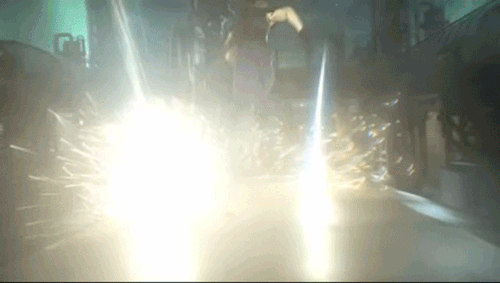
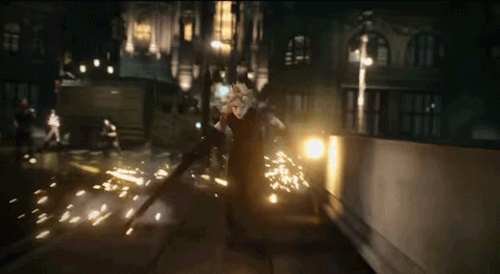
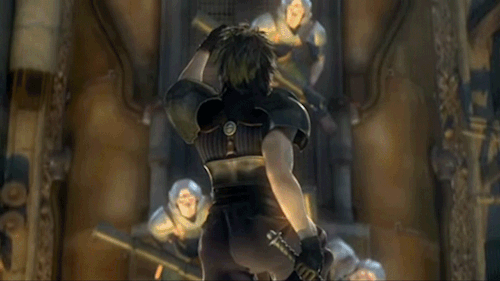
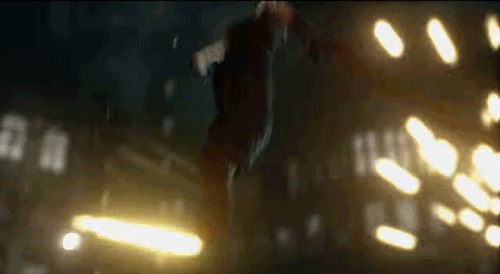
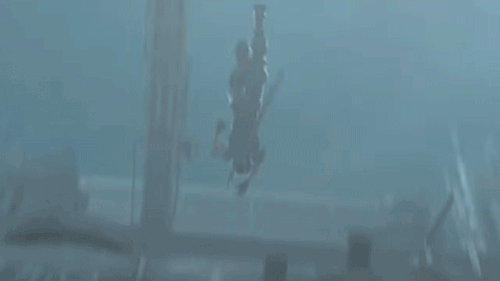
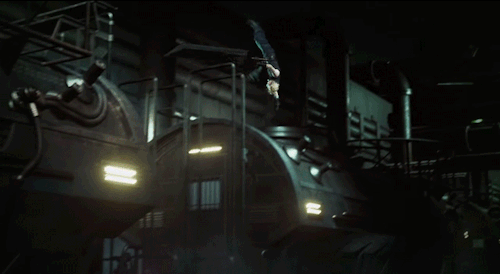
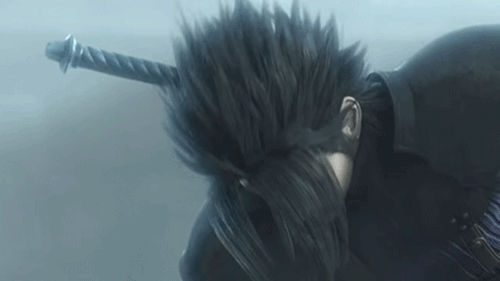
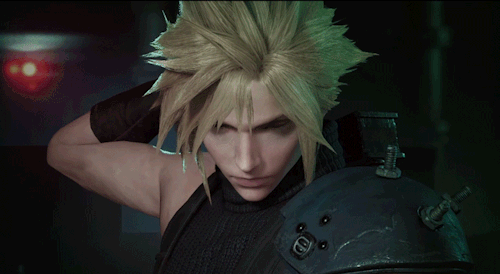
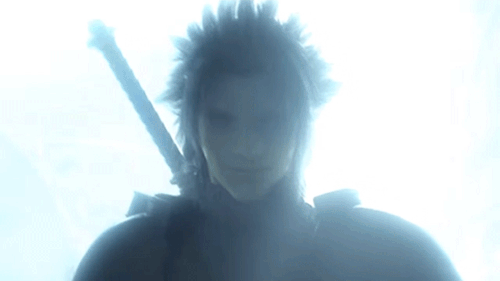
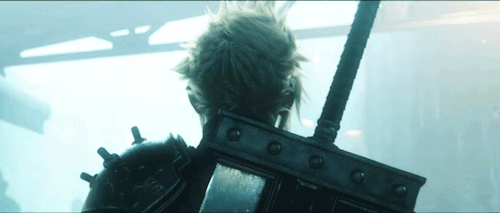
Zack and Cloud parallels
Crisis Core vs. Final Fantasy VII Remake
-
 abri-chan liked this · 2 months ago
abri-chan liked this · 2 months ago -
 portabella19 liked this · 3 months ago
portabella19 liked this · 3 months ago -
 silalcarin liked this · 5 months ago
silalcarin liked this · 5 months ago -
 laracroftess reblogged this · 1 year ago
laracroftess reblogged this · 1 year ago -
 ghostly-coffee liked this · 2 years ago
ghostly-coffee liked this · 2 years ago -
 nadiaaisyah reblogged this · 2 years ago
nadiaaisyah reblogged this · 2 years ago -
 nadiaaisyah liked this · 2 years ago
nadiaaisyah liked this · 2 years ago -
 rebekkapig liked this · 2 years ago
rebekkapig liked this · 2 years ago -
 something-somethings-posts reblogged this · 2 years ago
something-somethings-posts reblogged this · 2 years ago -
 something-somethings-posts liked this · 2 years ago
something-somethings-posts liked this · 2 years ago -
 ffvii-series-incorrect-quotes liked this · 3 years ago
ffvii-series-incorrect-quotes liked this · 3 years ago -
 dee-toraburu liked this · 3 years ago
dee-toraburu liked this · 3 years ago -
 lycoryllis liked this · 3 years ago
lycoryllis liked this · 3 years ago -
 tifas-cat liked this · 3 years ago
tifas-cat liked this · 3 years ago -
 chelociraptor liked this · 3 years ago
chelociraptor liked this · 3 years ago -
 autumn-lavelle liked this · 3 years ago
autumn-lavelle liked this · 3 years ago -
 laracroftess reblogged this · 3 years ago
laracroftess reblogged this · 3 years ago -
 laracroftess liked this · 3 years ago
laracroftess liked this · 3 years ago -
 merry--jelly liked this · 3 years ago
merry--jelly liked this · 3 years ago -
 neneeroo liked this · 3 years ago
neneeroo liked this · 3 years ago -
 jisungiespark liked this · 3 years ago
jisungiespark liked this · 3 years ago -
 makomoogle liked this · 3 years ago
makomoogle liked this · 3 years ago -
 terra-fatalis reblogged this · 3 years ago
terra-fatalis reblogged this · 3 years ago -
 terra-fatalis liked this · 3 years ago
terra-fatalis liked this · 3 years ago -
 peeka-beau liked this · 4 years ago
peeka-beau liked this · 4 years ago -
 a-crack-in-the-universe liked this · 4 years ago
a-crack-in-the-universe liked this · 4 years ago -
 kazxtorx liked this · 4 years ago
kazxtorx liked this · 4 years ago -
 lm0822 liked this · 4 years ago
lm0822 liked this · 4 years ago -
 dicentrasterisk liked this · 4 years ago
dicentrasterisk liked this · 4 years ago -
 aetherin21 reblogged this · 4 years ago
aetherin21 reblogged this · 4 years ago -
 staleface reblogged this · 4 years ago
staleface reblogged this · 4 years ago -
 starzplay3r liked this · 4 years ago
starzplay3r liked this · 4 years ago -
 giltenkreuz liked this · 4 years ago
giltenkreuz liked this · 4 years ago -
 lutty1234 liked this · 4 years ago
lutty1234 liked this · 4 years ago -
 crescendoll5555 liked this · 4 years ago
crescendoll5555 liked this · 4 years ago -
 glitterysongblizzard liked this · 4 years ago
glitterysongblizzard liked this · 4 years ago -
 amareinmortis liked this · 4 years ago
amareinmortis liked this · 4 years ago -
 nikoriin liked this · 4 years ago
nikoriin liked this · 4 years ago -
 wordwove liked this · 4 years ago
wordwove liked this · 4 years ago

Hardcore FFVII fan sharing theories & fanart, sometimes silly stuff ⋆ AuDHD ⋆ She/her ⋆ INTP ⋆ Atheist ⋆ Non-native English speaker, be merciful with my odd way of writing ⋆ Twitter @TerraFatalis
234 posts
